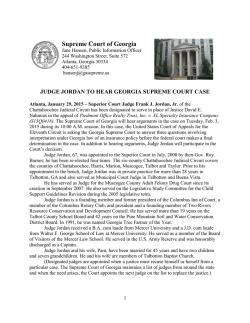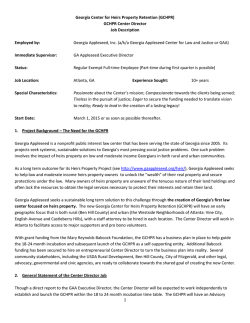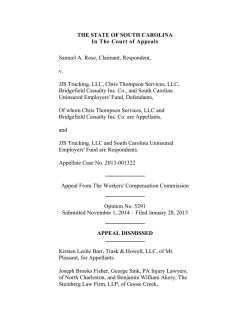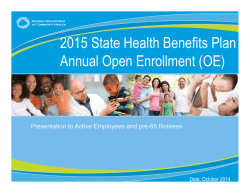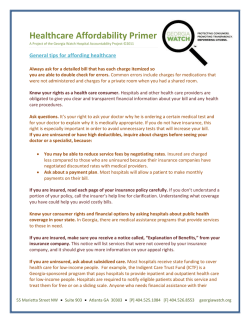
Healthcare Affordability in Georgia
Hospital Accountability Project Health care affordability in Georgia A project of nonprofit consumer advocacy group Georgia Watch, the Hospital Accountability Project examines the financial practices of nonprofit and for-profit hospitals in the state as they relate to health care consumers and affordability. Georgia Watch 55 Marietta Street Suite 903 Atlanta, GA 30303 (404) 525-1085 office (866) 33-WATCH toll-free (404) 526-8553 GeorgiaWatch.org [email protected] Georgia families are facing a crisis of affordable health as many struggle with exorbitant medical bills, chronic conditions and minimal access to adequate care. As recently as 1981, only 8 percent of families filing for bankruptcy did so in the aftermath of a serious medical problem. By contrast, more than half of all recent bankruptcies are the result of medical debt. Over the past few decades, the number of uninsured and underinsured Americans has grown as health costs and unemployment rise amid the economic recession. For an increasing number of Georgians, the threat of financial instability, foreclosure and bankruptcy is one that looms near due to medical debt that comes from the high cost of health care. According to a June 2009 study of foreclosures, approximately half were in part due to unmanageable medical bills, lost work due to a medical condition and caring for sick family members. Georgia currently ranks sixth in the nation for foreclosures. According to the Mortgage Bankers Association, more than 55,000 foreclosures were initiated in Georgia in the first half of 2009.i For example, according to a January 2007 report on debt as it relates to medical billsii: Nationally, average credit card debt was higher for low- and middle- income households ($11,623) as compared to households without a major medical expense in the previous three years or medical expenses contributing to their credit card debt ($7,964); Average credit card debt was higher for those without health insurance ($14,512) than for those with health insurance ($10,973); and, The medically indebted are more likely to be called by bill collectors than those struggling with other types of debt (62 percent versus 38 percent).iii A lack of health insurance can lead to a delay of needed care for a consumer who has any health conditions that could have been treated affordably and efficiently. Georgia ranks in the top ten for citizens that avoid preventative care due to high cost and a lack of insurance.iv In 2007, approximately 16.4 percent of the state’s residents reported they did not see a doctor in the last 12 months because of cost, a number more than 3 percent the national average. Unfortunately, without timely, low-cost care, health conditions can escalate to the point of needing emergency treatment, the most expensive type of care. This lack of preventative care directly impacts the consumer medically and financially, as the patient may now have high bills that could lead to bankruptcy and/or foreclosure. No one is immune from the threat of financial devastation, though uninsured and underinsured consumers are often most susceptible to the ill effects of high health care costs. Georgia’s uninsured Approximately one in four Georgians aged 18 to 64 had no form of health insurance in 2007, according to a Census report issued in August 2009.v Inside our Georgia communities, though, the numbers of uninsured vary greatly. For example, south central Georgia – which includes Tift, Bacon, Clinch, Echols, Brooks, Pierce and Lowndes counties – had the highest percentage of uninsured Georgians. 2 The immediate metro Atlanta area – Fulton, DeKalb, Gwinnett, Clayton, Cobb, Rockdale and Henry counties – has the lowest amount of uninsured residents (9 percent) in the state. However, 23 percent of the Fulton County’s adults aged 18 to 64 were uninsured. Other numbers from metro Atlanta illustrate that significant portions of the population lived without health insurance in 2007: 30 percent of Clayton County’s nonelderly adults had no insurance; 28 percent nonelderly adults went without coverage in DeKalb County; 26.5 percent of Gwinnett County’s nonelderly adults had no insurance; and, 19.3 percent of Cobb County nonelderly adults had no coverage.vi The number of uninsured African Americans is nearly double what it is for whites in Georgia. The rate of uninsured among Hispanics is also significantly higher than their white counterparts, in part because Hispanics are more likely to work in the agricultural or service sectors, where health benefits aren't offered and low wages bar workers from purchasing their own. In addition, federal law states immigrants living in the country for less than five years may not qualify for public insurance such as Medicaid or Medicare. Georgia has the sixth-highest number of residents without health insurance in the US and ranks 11th in its percentage of the population lacking coverage, according to a 2008 report from the Georgia State University’s Health Policy Center and the Center for Health Services Research. According to the report, only one in five individuals living below poverty have private insurance and nearly 38 percent are uninsured. Even so, many uninsured patients who do qualify for federal and state financial assistance programs do not utilize those programs. For example, in Fulton County, an estimated 20 percent of the county’s uninsured population qualify for existing public options such as Medicaid or PeachCare but were not enrolled in 2007.vii For Georgians, coverage dwindles High health care costs will cause about 248,000 Georgians to lose health care coverage between January 2008 and December 2010, according to a report issued by national nonprofit advocacy group Families USA.viii The report cites the leading factor in coverage loss is the rising cost of health care premiums – up 119 percent from 1999 to 2008. By contrast, the Consumer Price Index only reported a 29.2 percent increase in inflation. Between 2008 and 2010, the report claims that, in Georgia: 1,590 people will lose their health coverage, on average, every week; 3 6,890 people will lose their health coverage, on average, every month; and 82,720 people will lose their health coverage every year.ix Even still, many who have health insurance may lack adequate coverage, falling into the category of the “underinsured.” Those considered “underinsured” have health insurance that falls short of adequately covering health care needs, and often spend 10 percent or more of their annual income on health care costs. For example, a person who makes $40,000 a year and spends $4,000 or more on premiums, deductibles, co-pays for hospital visits and medication, or other health care-related costs, is considered underinsured. National nonprofit health care group Community Catalyst reported in April 2009 that one-fifth of all insured adults in the US – about 25 million citizens – were underinsured in 2007. This vulnerable group of Americans has grown by 60 percent since 2003. Through limited coverage and high deductibles, the underinsured can still face financial ruin due to high health care costs.x The true cost of care While Georgia’s health costs are fairly consistent among national averages, the price tag of care is still high compared to cost. In 2007, services, procedures, drugs and supplies only cost the hospital $0.43 for every $1.00 charge, though the amount varies from facility to facility. For example, at one Fulton Countybased hospital, patients were charged $1.00 for services, drugs and procedures that cost the hospital an overall $0.45. But at a similar facility only about 13 miles away, there was a significant mark-up of charge over cost – the hospital charged its patients $1.00 for every $0.15 it spent.xi $0.70 Cost vs. charge for DeKalb and Fulton County acute care hospitals $0.60 $0.50 $0.40 $0.30 $0.20 $0.10 $0.00 4 Without the financial resources and adequate insurance to cover their health care costs, many patients will seek care in the emergency room – the only access point to the hospital for most uninsured patients. According to a report issued in July 2009, uninsured patients comprise approximately one-fifth of all emergency room visits.xii Each year, the number of self-pay and/or uninsured patients aged 20 to 59 visiting a Georgia ER increases 800,000 600,000 400,000 200,000 0 2005 2006 2007 Between 2005 and 2007, the number of visits for uninsured and/or self-pay adults visiting the emergency room rose more than 19 percent in Georgiaxiii, likely creating a significant impact on the pocketbooks of the state’s uninsured. While some patients live in urban areas with health clinics that can provide primary and preventative care for a lower cost, many patients outside metropolitan areas have limited options due to a lack of resources beyond the county health department, which offers limited services. In addition, public transportation is either scarce or non-existent, often leaving some with no reliable way to access low-cost care options. When these patients finally do make it to a hospital, their condition is more advanced and more expensive to treat, meaning their bills are likely to be higher. The average emergency room visit costs $1,000, as compared to the average clinic visit of $29 and an average primary care doctor visit that can range from $75 to $120. Community-based initiatives There are some community-based endeavors throughout Georgia that have begun to address the issue of health care affordability for the uninsured and underinsured consumers in their regions. For example, hospitals, county and local governments, health care providers and clinics in a seven-county area of central Georgia have banded together to help uninsured and underinsured consumers with certain chronic conditions through a program called Community Health Works. Since its creation in 2001, the program has served nearly 4,000 uninsured residents with at least one of the four chronic conditions: hypertension, diabetes, heart disease and depression.xiv Through efficient and appropriate use of health services, Community Health Works stresses stringent case management across the continuum of care. As of 2008, the program estimates that its enrollees use 5 hospitals for treatment approximately 45 percent less than before, and enter the emergency room about 15 percent fewer times due to proper medication and preventative care. Similarly, since 1999, the East Georgia Health Cooperative has undertaken two primary initiatives to address the issue of health access in a 17-county area known as the “diabetes belt.” Beginning in 2001, EGHC linked community residents and health care providers through increased health screenings, referring those at risk for diabetes to education programs for patients and physicians. xv In 2009, EGHC shifted focus to assist group purchasing programs for clinics as a way to save money on health equipment and certain other needs. By minimizing overhead costs, these clinics are able to continue providing muchneeded discounted and free care to eligible uninsured and underinsured patients. Conclusion Access to affordable care has been shown to double a family’s ability to save and to stave off financial devastation. And with financially-accessible care comes better health, which in turn keeps costlier health procedures at bay. By utilizing a more comprehensive approach to care we can reduce costs and improve our quality of life. Hospital executives, community leaders, advocacy groups and consumers must work together to help curb health care costs though both consumer-friendly hospital policy and public policy and regulations. i Mortgage ii Bankers Association, National Delinquency Survey, 2009, Second Quarter. “Borrowing to Stay Healthy: How Credit Card Debt is Related to Medical Expenses.” Cindy Zeldin and Mark Rukavina, January 2007. iii Ibid. iv www.statehealthfacts.org/ profileind.jsp?ind=747&cat=8&rgn=12 v “Income, vi Poverty, and Health Insurance Coverage in the United States: 2008.” United States Census Bureau, September 2008. Ibid. vii “Alternatives viii “The for Funding Indigent Care Beyond the Public Hospital.” Fulton County, November 2007. Clock is Ticking: More Americans Losing Health Coverage.” Families USA, July 2009. ix Ibid. x “When Coverage Fails: Causes and Remedies for Inadequate Health Insurance.” Community Catalyst, April 2009. xi Annual Hospital Financial Survey, Georgia Department of Community Health. xii Nationwide Emergency Department Sample, Agency for Healthcare Quality and Research, Department of Health and Human Services, July 2009. xiii Oasis.state.ga.us xiv www.chwg.org xv www.eghealthcoop.org 6
© Copyright 2024
